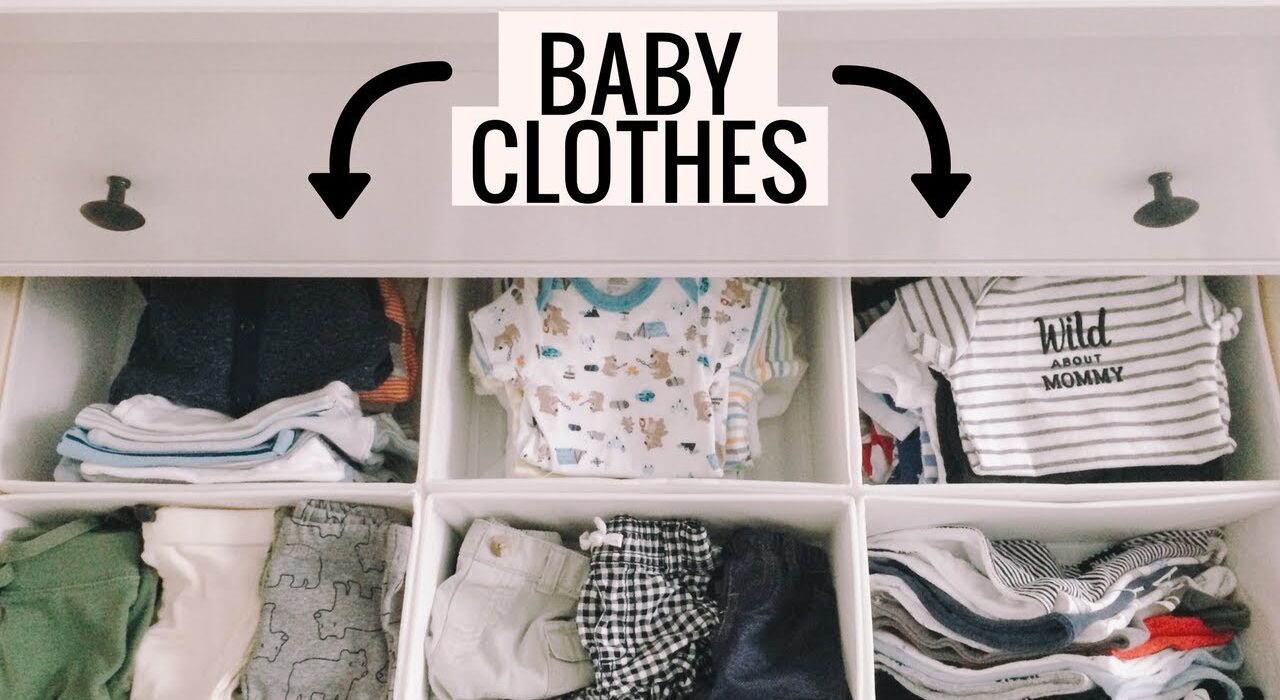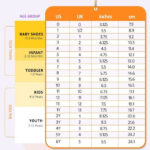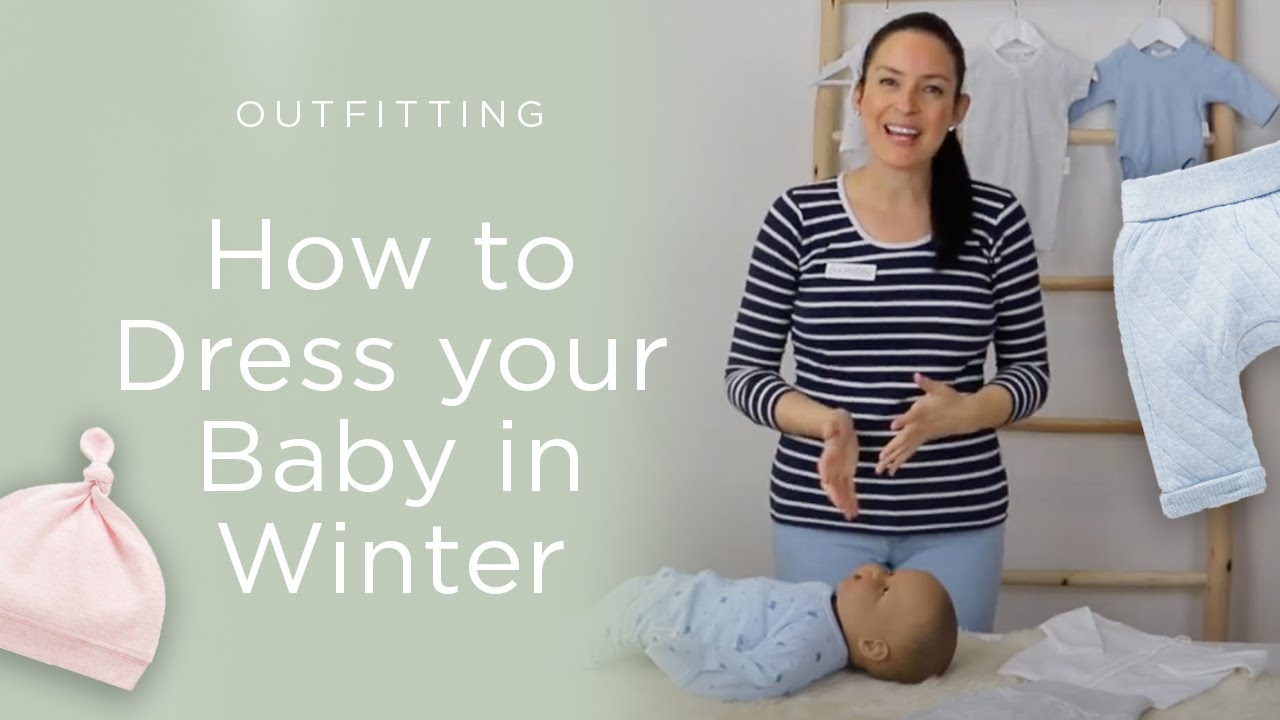To store newborn clothes, first wash and thoroughly dry them. Then, organize them by size and type in labeled bins or drawers.
Storing newborn clothes can be a challenge for new parents. Babies grow quickly, making it essential to keep their wardrobe organized and accessible. Proper storage not only helps maintain the clothes’ quality but also makes dressing your little one much easier.
Consider using clear bins for visibility or drawer organizers to separate items like onesies, sleepers, and accessories. This method ensures you can find what you need without digging through piles. With a little planning, you can create a system that saves time and space, allowing you to focus more on those precious moments with your newborn.
Table of Contents
Introduction To Newborn Clothing Storage
Proper storage of newborn clothes is essential for their longevity. Babies grow fast. Clothes can quickly become too small. Storing them correctly helps maintain their quality. It also saves you time and money. Let’s explore how to store newborn clothes easily.
Significance Of Proper Storage
Storing newborn clothes properly has many benefits:
- Preservation: Keeps fabrics in good condition.
- Organization: Makes finding items easier.
- Space-saving: Maximizes storage areas in your home.
- Hygiene: Protects clothes from dust and pests.
Good storage practices ensure you can reuse clothes for future siblings. It also helps to pass them down to friends or family.
Challenges With Newborn Garments
Newborn clothes come with unique challenges:
- Size Variability: Babies grow quickly, so sizes change fast.
- Material Sensitivity: Some fabrics require special care.
- Frequent Changes: Babies need multiple outfit changes each day.
- Limited Space: Newborn clothes can take up valuable space.
Understanding these challenges helps create effective storage solutions. This ensures your baby’s wardrobe remains manageable and efficient.
Sorting Newborn Clothes
Sorting newborn clothes helps keep everything organized. It makes dressing your baby easier. Follow these simple tips to sort effectively.
By Size And Season
Start by sorting clothes by size. Newborns grow fast. Organize clothes into these categories:
- Preemie
- Newborn
- 0-3 months
- 3-6 months
Next, sort by season. This helps you find outfits quickly. Here’s a quick guide:
| Season | Clothing Types |
|---|---|
| Spring/Summer | Short sleeves, light fabrics, shorts |
| Fall/Winter | Long sleeves, warmer fabrics, jackets |
Distinguishing Between Rare And Frequent Use
Identify which clothes your baby wears often. Separate them from rarely used items. This makes dressing simple.
- Frequent Use: Everyday outfits, sleepwear, and essentials.
- Rare Use: Special occasion outfits, seasonal clothes.
Store frequently used clothes in easy-to-reach places. Use bins or drawers. Keep rare items in storage boxes. Label everything clearly.
This method saves time. You’ll find what you need quickly. Enjoy dressing your little one with ease!
Cleaning Before Storage
Keeping newborn clothes clean before storage is crucial. It ensures they stay fresh and ready for future use. Proper cleaning prevents odors, stains, and bacteria. This section covers essential washing and drying tips, along with ways to address stains and odors.
Washing And Drying Tips
Follow these steps to wash and dry newborn clothes effectively:
- Use a Gentle Detergent: Choose a detergent designed for babies.
- Cold Water Wash: Wash clothes in cold water to prevent shrinking.
- Hand Wash Delicates: For delicate fabrics, hand wash to avoid damage.
- Dry Naturally: Hang clothes to air dry whenever possible.
- Avoid Fabric Softeners: They can irritate a baby’s sensitive skin.
Addressing Stains And Odors
Stains and odors need immediate attention. Follow these methods:
- Act Quickly: Treat stains as soon as possible.
- Use Stain Remover: Apply a baby-safe stain remover directly on stains.
- Soak in Vinegar: Soak clothes in a mixture of water and vinegar to remove odors.
- Rinse Thoroughly: Always rinse clothes well after applying any treatment.
Store only clean and dry clothes. This keeps them fresh for future use.
Choosing The Right Containers
Storing newborn clothes properly keeps them organized and clean. The right containers protect clothes from dust and damage. Choose containers that suit your space and needs. Let’s explore the best options available.
Types Of Storage Containers
Different types of storage containers work well for newborn clothes. Here are some popular choices:
- Plastic Bins: Durable and stackable.
- Fabric Storage Baskets: Soft and lightweight.
- Cardboard Boxes: Cost-effective but less durable.
- Vacuum-Sealed Bags: Saves space and keeps clothes fresh.
| Container Type | Durability | Space-Saving |
|---|---|---|
| Plastic Bins | High | Yes |
| Fabric Baskets | Medium | Limited |
| Cardboard Boxes | Low | No |
| Vacuum-Sealed Bags | Medium | Yes |
Benefits Of Clear Bins
Clear bins offer several advantages for storing newborn clothes:
- Visibility: Easily see what’s inside.
- Organization: Keep clothes sorted by size or season.
- Stackable: Save space in your home.
- Durable: Protect clothes from moisture and dust.
Using clear bins simplifies the storage process. You can quickly find what you need without digging through various containers. This saves time and reduces stress.
Climate Control For Clothing Longevity
Proper climate control is key for storing newborn clothes. It helps keep fabrics fresh and safe. Temperature and humidity directly impact their condition. Here’s how to manage these factors effectively.
Importance Of Temperature Regulation
Maintaining the right temperature is crucial. Extreme heat or cold can damage fabrics. Ideal storage temperature is between 65°F and 75°F.
- Avoid basements and attics.
- Use a climate-controlled room.
- Check temperature regularly.
Storing clothes in a stable environment ensures they last longer. This practice prevents color fading and fabric wear.
Humidity And Its Impact
Humidity plays a significant role in clothing preservation. High humidity can cause mold and mildew. Low humidity leads to dry, brittle fabrics.
| Humidity Level | Impact |
|---|---|
| Above 60% | Risk of mold and mildew |
| 30% – 60% | Optimal for storage |
| Below 30% | Fabrics may become brittle |
Use a dehumidifier in damp areas. Store clothes in breathable bags. Check humidity levels regularly for best results.

Credit: m.youtube.com
Maximizing Closet Space
Storing newborn clothes can be a challenge. Closets often feel small. Maximizing closet space helps keep everything organized. This way, you can find outfits quickly. Here are some tips to make the most of your closet.
Utilizing Vertical Space
Vertical space is often underused. You can store more items by going up. Here are some ways to utilize it:
- Hanging Rods: Install an extra rod above the existing one. Use it for smaller clothes.
- Hooks: Attach hooks on the wall. Hang hats, bibs, or bags.
- Stackable Bins: Use stackable bins on shelves. They help store seasonal items.
Each method saves floor space. It keeps clothes easily accessible.
Closet Organizers And Dividers
Organizers and dividers make a big difference. They create order in your closet. Here are some options:
| Type | Description |
|---|---|
| Drawer Dividers | Separate tiny clothes in drawers. |
| Hanging Organizers | Store shoes, accessories, or folded clothes. |
| Fabric Bins | Use for bulk items like blankets or swaddles. |
Choosing the right organizers simplifies your life. It makes finding clothes easy.
Fold Vs. Hang
Deciding between folding and hanging newborn clothes is important. Each method has its benefits. Choose based on space, fabric type, and frequency of use. Proper storage keeps clothes organized and ready for use.
Best Practices For Folding
Folding baby clothes correctly saves space and prevents wrinkles. Follow these best practices:
- Use a flat surface: Find a clean area to fold.
- Organize by size: Keep similar sizes together.
- Roll for extra space: Rolling saves space and reduces wrinkles.
- Stack neatly: Place items in stacks for easy access.
- Label drawers: Use labels for quick identification.
When To Hang Baby Clothes
Some baby clothes benefit from hanging. Use this method for:
- Delicate fabrics: Hang items made from silk or lace.
- Outfits with embellishments: Protect decorations from crushing.
- Frequently worn clothes: Keep outfits ready for quick access.
- Items needing air circulation: Hanging helps fabrics breathe.
Choose sturdy hangers. Use padded hangers for delicate items. Avoid wire hangers, as they can damage clothes.
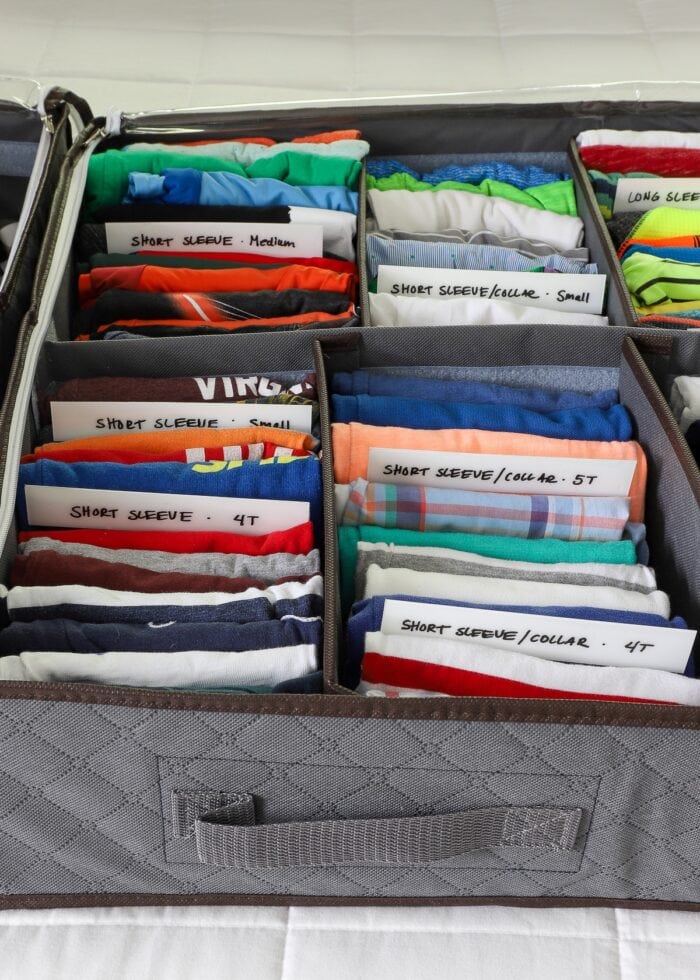
Credit: thehomesihavemade.com
Labeling For Easy Identification
Storing newborn clothes can be a challenge. Using labels helps you find items quickly. An organized system saves time and reduces stress. Here’s how to implement effective labeling for easy identification.
Tagging Systems
Choose a tagging system that works for you. Here are some popular options:
- Printable Labels: Print labels at home. Use a label maker for a neat look.
- Safety Pins: Attach tags with safety pins. Easy to move around.
- Fabric Tags: Sew labels into clothes. Permanent and durable.
Make sure the tags include:
- Size
- Season
- Type of clothing
This way, you can quickly spot what you need.
Color Coding Benefits
Color coding simplifies finding clothes. Assign colors based on sizes or seasons.
| Color | Size |
|---|---|
| Red | Newborn |
| Blue | 0-3 Months |
| Green | 3-6 Months |
This method allows quick identification. You’ll save time during busy days.
Labeling newborn clothes effectively ensures an organized system. Easy access makes parenting smoother.
Tips For Storing Shoes And Accessories
Storing newborn shoes and accessories requires organization. Proper storage keeps these small items safe and easy to find. Here are some effective tips to help you manage these essentials.
Organizing Small Items
Small items can easily get lost. Use clear containers for storage. This allows you to see what’s inside.
- Sort by type: shoes, hats, or socks.
- Label containers for easy identification.
- Use drawer dividers to separate items.
Consider using a shoe organizer. Hang it on the back of a door. This saves space and keeps shoes visible.
Preventing Misplacement
To prevent misplacing accessories, establish a dedicated storage area. Always return items to their designated spot.
- Choose a specific shelf for shoes.
- Use hooks for hats and bags.
- Keep socks in a drawer or basket.
Regularly check and reorganize the storage area. This ensures everything remains in its place.
Safekeeping Heirloom And Sentimental Pieces
Newborn clothes often hold special memories. Some items become family treasures. Properly storing these pieces is essential. This keeps them safe for future generations.
Preservation Techniques
Use the following techniques to preserve your treasured items:
- Clean before storing. Wash clothes in gentle detergent.
- Avoid using bleach. It can damage fabrics.
- Air dry instead of using a dryer. This reduces wear.
- Store in a cool, dry place. Avoid moisture to prevent mold.
Check items regularly for signs of damage. Early detection helps maintain their condition.
Special Containers For Keepsakes
Choosing the right container is vital. Here are some options:
| Container Type | Features |
|---|---|
| Acid-free boxes | Prevents yellowing and deterioration. |
| Plastic bins | Waterproof and stackable. |
| Garment bags | Protects from dust and light. |
Label each container clearly. Include details like size, date, and significance. This helps identify items easily.
Frequent Reevaluation Of Storage Needs
As your newborn grows, storage needs change quickly. Regularly checking clothing storage helps keep things organized. It ensures you have the right sizes and types of clothes on hand.
Adapting To Growth Spurts
Newborns grow fast. Clothes can quickly become too small. Here are some tips to handle this:
- Check Sizes Monthly: Look at your baby’s clothes each month.
- Sort by Size: Group clothes into sizes. This makes finding the right fit easier.
- Donate or Store: Remove clothes that no longer fit. Donate them or store for future use.
Growth spurts happen unexpectedly. Be prepared by having a storage plan. Keep a separate bin for outgrown clothes. Label bins clearly for easy access.
Seasonal Clothing Rotation
Seasons change. So do clothing needs. Rotate clothes based on the season:
- Winter Clothes: Store away summer items.
- Spring and Summer: Bring out lighter clothes.
- Label Everything: Use clear labels for easy identification.
Consider a simple table for seasonal clothing:
| Season | Clothing Types |
|---|---|
| Winter | Warm jackets, hats, and socks |
| Spring | Light jackets, long sleeves |
| Summer | Short sleeves, shorts, and swimsuits |
| Fall | Layered outfits, sweaters |
By rotating clothes seasonally, you keep your storage efficient. It helps you find what you need quickly. This method also saves space in your home.
Incorporating Space-saving Products
Newborn clothes can take up a lot of space. Using smart storage solutions helps keep things organized. Space-saving products make it easy to store and access these tiny garments. Here’s how to utilize these effective tools.
Vacuum Seal Bags
Vacuum seal bags are a great way to save space. They compress clothing, reducing their volume significantly. Here’s how to use them:
- Choose high-quality vacuum bags.
- Sort clothes by size and season.
- Place clothes flat inside the bag.
- Seal the bag according to instructions.
- Use a vacuum to remove air.
These bags can fit easily under beds or in closets. They protect clothes from dust and moisture. You can label bags for quick access.
Compact Shelving Solutions
Compact shelving solutions maximize vertical space. Use shelves to store newborn clothes efficiently. Here are some ideas:
- Install wall-mounted shelves.
- Use cubby storage units.
- Opt for a tall dresser.
Consider using decorative boxes on shelves. They can store items neatly while looking good. Use labels to identify contents quickly.
These solutions keep clothes organized. You can easily find what you need during busy times.
| Product | Benefits |
|---|---|
| Vacuum Seal Bags | Saves space, protects from dust, easy access |
| Compact Shelves | Maximizes space, organized, visually appealing |
Sharing And Donation Strategies
Newborn clothes can pile up quickly. Sharing and donating these items helps others. It also clears space in your home. Here are some effective strategies for gifting and donating.
Gifting Outgrown Clothes
Passing on outgrown clothes is a thoughtful gesture. Consider these options:
- Friends and Family: Offer clothes to those with newborns.
- Baby Showers: Gift clothes to expectant parents.
- Social Media Groups: Join local parenting groups to share items.
Make sure the clothes are clean and in good condition. Include a personal note for a special touch. This small gesture can mean a lot.
Where To Donate
Many organizations accept baby clothes. Donating helps those in need. Here are some great places to consider:
| Organization | Contact Information | Notes |
|---|---|---|
| Goodwill | Website: goodwill.org | Accepts all types of baby clothes. |
| Salvation Army | Website: salvationarmyusa.org | Offers donation pick-up services. |
| Local Hospitals | Call: Check your local directory. | Some hospitals accept donations for new parents. |
| Baby2Baby | Website: baby2baby.org | Provides essentials to families in need. |
Check with each organization for specific donation guidelines. Make sure clothes are clean and gently used. Spread kindness through sharing and donating.
Innovative Storage Hacks
Storing newborn clothes can be a challenge. Creative solutions make it easier. Keep things organized and accessible. Here are some innovative storage hacks to consider.
Diy Solutions
Creating your own storage can be fun and useful. Try these DIY ideas:
- Repurposed Baskets: Use old baskets for easy sorting.
- Drawer Dividers: Create sections with cardboard or wood.
- Hanging Organizers: Use shoe organizers for tiny clothes.
- Labeling: Label bins for quick identification.
These solutions help save space and time. You can personalize them to fit your style.
Multipurpose Furniture
Choose furniture that serves more than one purpose. This saves space and adds functionality:
| Furniture Type | Storage Benefits |
|---|---|
| Storage Ottomans | Store clothes and provide seating. |
| Cribs with Drawers | Keep essentials close at hand. |
| Changing Tables | Provide storage for diapers and clothes. |
| Bookshelves | Use baskets to organize clothes and toys. |
Multipurpose furniture is a smart choice. It keeps your space tidy and functional.
Conclusion: Maintaining An Organized System
Keeping newborn clothes organized saves time and reduces stress. An effective system helps you find what you need quickly. It also ensures your baby’s clothes stay clean and in good condition.
Regular Upkeep
Set a routine for checking and organizing clothes. Regular upkeep makes sure everything stays in order.
- Check clothes weekly for cleanliness.
- Sort out items that no longer fit.
- Reorganize as your baby grows.
Use these simple steps:
- Gather all clothes in one place.
- Sort them by size and season.
- Store out-of-season clothes in bins.
Benefits Of An Organized Approach
An organized system has many advantages:
| Benefit | Description |
|---|---|
| Time-saving | Quickly find what you need. |
| Stress-free | No more searching through piles. |
| Clothes in Good Condition | Protects clothes from damage. |
| Clear Space | Maximizes storage efficiency. |
Organized clothes promote a calm environment. A neat space keeps your mind clear. Enjoy the process of caring for your newborn with ease.
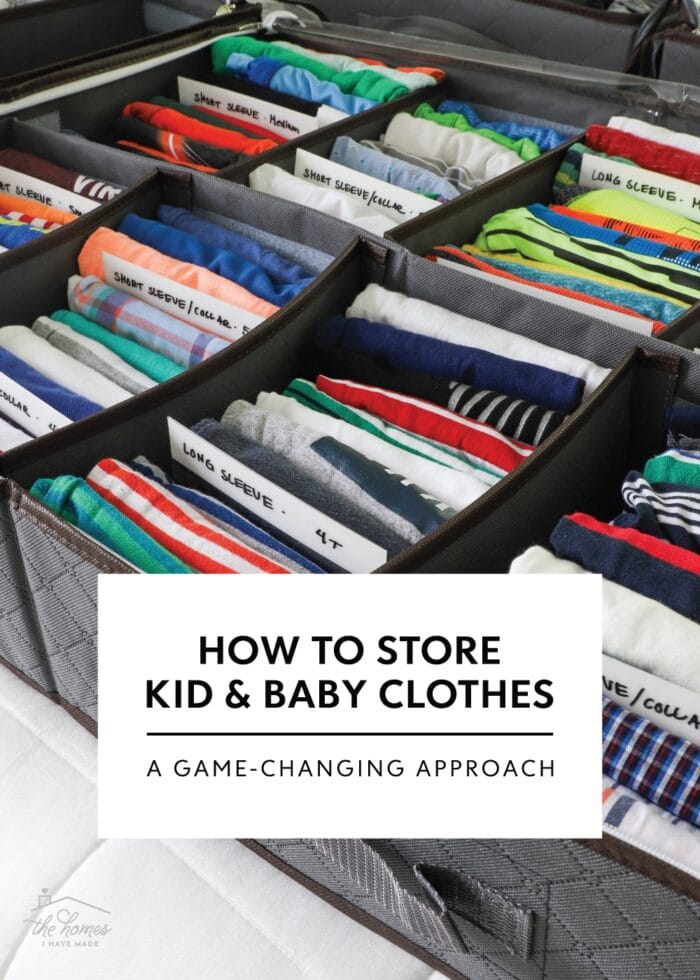
Credit: thehomesihavemade.com
Frequently Asked Questions
How Should I Organize Newborn Clothes?
Sort newborn clothes by size, type, and season for easy access.
What Is The Best Way To Store Baby Clothes?
Use clear bins or drawers to keep baby clothes organized and visible.
Can I Store Newborn Clothes In The Basement?
Avoid basements due to humidity; choose a dry, climate-controlled area instead.
How Often Should I Rotate Newborn Clothes?
Rotate clothes seasonally or as the baby grows to keep the wardrobe fresh.
Should I Wash Clothes Before Storing Them?
Always wash clothes before storing to prevent odors and protect against pests.
Conclusion
Storing newborn clothes properly ensures they remain clean and ready for use. Use labeled bins for easy access. Keep items in a cool, dry place to prevent mold and damage. Regularly check the condition of the clothes. With these tips, you can keep your baby’s wardrobe organized and fresh for every occasion.



